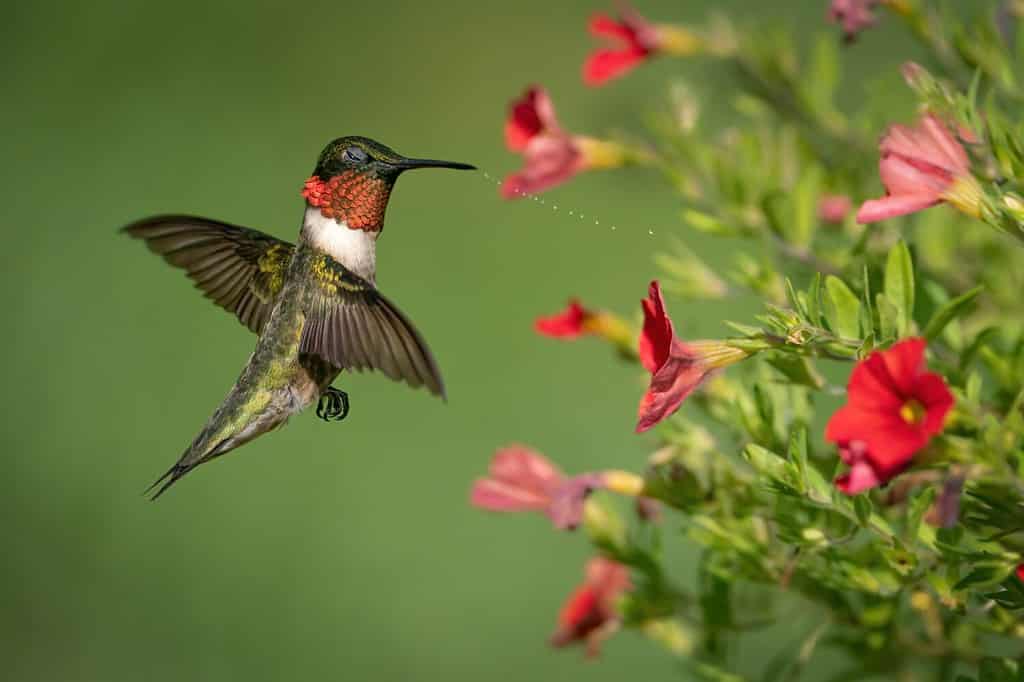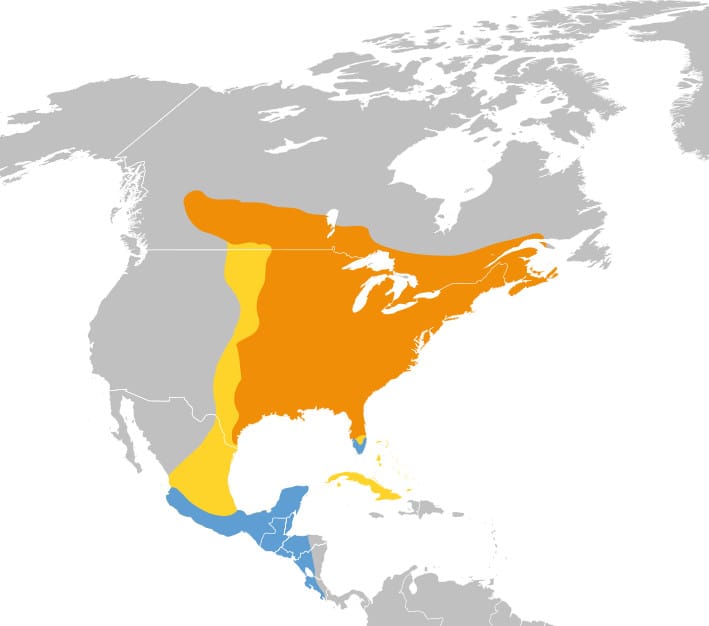In the northeastern corner of the United States, Vermont’s picturesque landscapes provide a summer haven for hummingbirds. These tiny creatures, with their vibrant feathers and mesmerizing flight patterns, bring joy and wonder to all who have the pleasure of observing them. However, as the seasons change and cooler temperatures approach, it’s only natural to wonder when these delightful birds bid farewell to Vermont.
In this article, we delve into the fascinating world of hummingbird migration, exploring when and why these remarkable creatures leave Vermont, and how we can ensure their safe passage and continued well-being. Whether you have been captivated by the fleeting beauty of hummingbirds or are simply curious about the intricacies of their migratory patterns, join us on this exploration as we bid farewell to the hummingbirds of Vermont and celebrate the awe-inspiring wonders of nature.
When Do Hummingbirds Leave Vermont?

Hummingbirds typically start to leave the state of Vermont in September.
©Steve Byland/ via Getty Images
As summer transitions to autumn, the hummingbirds in Vermont gradually prepare for their long journey to warmer climates. Here are a few key points to consider regarding the departure of these fascinating creatures:
September Departures:
In Vermont, hummingbirds are commonly seen departing during the month of September. This is when they start their migration southward, navigating their way to their wintering grounds in Central America or Mexico.
Individual Variations:
It’s important to note that not all hummingbirds leave Vermont at the same time. Some individuals may depart earlier, while others may linger for a bit longer, taking advantage of late-season food sources.
Hummingbird Departure in Vermont: Signs to Look Out For
Keep your senses sharp, and you’ll be able to witness the magical departure of hummingbirds up close. Here are a few indicators to guide you:
Diminished Feeder Activity:
Notice a decline in hummingbird visits to your feeders as fall approaches. Hummingbirds typically decrease their nourishment intake and become less dependent on feeders before migration.
Decreased Flower Visits:
Observe a decline in hummingbird activity around flowers, as their preferred nectar sources dwindle with the season. While some late-blooming flowers may still attract hummingbirds, overall visitation will decrease as they prepare for migration.
Flocking Behavior:
Keep an eye out for hummingbirds gathering in small groups before departure. These flocks serve as a social network for migration, allowing individuals to share information on suitable stopovers along the way.
Intensified Feeding:
Witness an increased feeder and flower visitation frenzy during the days preceding migration.
Hummingbirds intensely refuel to store the energy required for their long journey.
Lengthening Days:
Note the changing daylight hours as fall progresses. Hummingbirds start relying on day length as an important cue to trigger their migration instinct.
Native Hummingbird Species Migration in Vermont:
Ruby-throated Hummingbirds:

The most common species of hummingbird in Vermont is the
Ruby-throated Hummingbird
.
©Cavan-Images/Shutterstock.com
The most common hummingbird species found in Vermont, these tiny birds embark on an extraordinary journey each year. Around April, they begin their northward migration from Central America, traveling thousands of miles before reaching their breeding grounds in Vermont by late May. In the fall, they undertake an equally impressive southward journey, making their way back to their wintering grounds in Mexico and Central America.
Non-Native Species Of Hummingbirds That Migrate Through The State Of Vermont
The Ruby-throated Hummingbird is the only hummingbird species native to Vermont. While other hummingbird species may occasionally visit Vermont as vagrants, they are not considered regular migrants through the state. The Ruby-throated Hummingbird is the most common species in Vermont and is known for its vibrant green feathers and ruby-red throat patch. It is the only species that reliably migrates through Vermont during its annual migration from Central America to North America.
While less common in Vermont, Rufous Hummingbirds occasionally make an appearance during migration. These striking birds breed in western North America and fly eastward during the fall, crossing through Vermont on their way to their wintering grounds in Mexico.
Are There Any Hummingbirds That Spend The Winter In Vermont?
there are species of hummingbirds that spend the winter in Vermont. The most common species is the Ruby-throated Hummingbird (Archilochus colubris). While most Ruby-throated Hummingbirds migrate to Central America or Mexico for the winter, some individuals may stay in Vermont if there is a reliable food source available, such as a hummingbird feeder with nectar or late-blooming flowers.
This behavior is known as “wintering” and is more commonly observed in southern parts of the state where the climate is slightly milder. However, it is important to note that wintering hummingbirds in Vermont are rare and their survival during the colder months is challenging. Providing supplemental food sources can help increase their chances of survival if they choose to winter in the area.
Factors Influencing Hummingbird Migration Patterns in Vermont

Ruby-throated hummingbird range map – There are many factors that impact the migration of this particular hummingbird species.
There are several factors that influence hummingbird migration patterns in Vermont. Some of the main factors include:
Food Availability:
Hummingbirds migrate to areas where there is an abundance of nectar-producing flowers and insects. The availability of food sources plays a significant role in their migration patterns. In Vermont, hummingbirds typically migrate to areas with a diverse range of flowering plants and a long blooming season.
Temperature and Climate:
Hummingbirds are highly sensitive to temperature changes. They are more likely to migrate to warmer regions during the winter months when the temperatures drop significantly in Vermont. Warmer climates provide a more suitable environment for their survival.
Daylight Hours:
Hummingbirds rely on daylight hours as a cue for migration. As the days become shorter in Vermont, it signals to the hummingbirds that it is time to start migrating south. The length of daylight hours is crucial in determining the timing of their migration.
Breeding and Nesting Requirements:
Hummingbirds migrate to areas that provide suitable breeding and nesting conditions. They require specific habitats, such as forests with trees and shrubs for nesting purposes. Availability of suitable breeding grounds influences their choice of migration routes.
Geographic Barriers:
Physical barriers such as mountains and large bodies of water can influence hummingbird migration patterns. These barriers may force hummingbirds to take alternative routes or concentrate in specific areas during their migration.
Wind Patterns:
Hummingbirds are small and lightweight birds, making them susceptible to wind patterns. They tend to rely on favorable winds for their migration, allowing them to conserve energy during long flights. Wind patterns can influence the speed and direction of their migration.
Genetic Predisposition:
Each individual hummingbird has a genetic predisposition for migration. Some hummingbirds may have a stronger instinct to migrate, while others may have a weaker inclination. These genetic factors can influence their migration patterns and the distances they travel.
Hummingbird Migration and the Impact on Vermont’s Ecosystem
As hummingbirds travel, they play a crucial role in Vermont’s ecosystem through the pollination of various plant species, including many native wildflowers. The state’s diverse array of flowering plants provides a critical source of food for these birds. Hummingbirds have a high metabolic rate and need to consume nectar frequently to fuel their energy-demanding flight. By feeding on nectar from Vermont’s flowers, they aid in the pollination of these plants, promoting their reproduction and genetic diversity.
Furthermore, as hummingbirds feed on nectar, they inadvertently transfer pollen from one flower to another, facilitating cross-pollination. This process promotes genetic diversity within plant populations, enhancing their resilience to environmental pressures such as disease or climate change. Therefore, the presence of hummingbirds in Vermont contributes to the overall health and diversity of the state’s ecosystems.
However, the impact of hummingbird migration on Vermont’s ecosystem is not one-sided. The birds also rely on specific environmental conditions to survive and thrive. Climate change, habitat loss, and the use of pesticides pose significant threats to their populations. As these birds require a consistent and abundant supply of nectar-rich flowers throughout their migration, any disruption or degradation of their habitat can have detrimental effects on their survival.
Where Do Hummingbirds Go When They Leave Vermont?
When hummingbirds leave Vermont, they typically migrate south to warmer regions for the winter. In general, hummingbirds from Vermont will travel to Central America, specifically areas such as Mexico, Belize, Guatemala, and Honduras. These regions provide suitable habitats and sources of nectar for the hummingbirds during the winter months. The specific destinations can vary among individual birds, but the general pattern is for them to migrate southward to these Central American countries.
When Do Hummingbirds Return To Vermont?

Hummingbirds usually make their way back to Vermont in early May.
©iStock.com/BonneChance
Hummingbirds typically return to Vermont at the beginning of May. The Ruby-throated Hummingbird, the most common species in Vermont, arrives in mid-April. Males usually arrive a few weeks before females. They spend the breeding season in Vermont and are commonly seen from April to October.
How To Help Hummingbirds When They Return to Vermont

Male Ruby Throated Hummingbird at Feeder
©Christine Balleau/iStock via Getty Images
When hummingbirds return to Vermont in the spring, there are a few ways you can help provide a welcoming environment for them. Here are some tips:
Provide a Variety of Nectar-Rich Flowers:
Hummingbirds rely on nectar as their primary food source. Plant a diverse range of flowers including tubular-shaped blooms such as trumpet vine, bee balm, columbine, cardinal flower, and red hot poker. Planting flowers of different colors and shapes will attract a wider array of hummingbird species.
Hang Hummingbird Feeders:
Supplement natural nectar sources with hummingbird feeders filled with a simple 4:1 sugar-water solution. Avoid using red dye in the mixture, as it can be harmful to hummingbirds. Hang the feeders in a shady, quiet area that is easily accessible for hummingbirds. It’s important to clean the feeders regularly to prevent the growth of mold and harmful bacteria.
Provide Water Sources:
Hummingbirds also need water for grooming and drinking. Create a shallow bird bath or add a small fountain or mister to your garden. Make sure to keep the water source clean and provide fresh water regularly.
Create Hummingbird-Friendly Habitats:
Hummingbirds need suitable nesting sites, perches, and shelter. Plant shrubs, trees, or vines that provide cover and perching spots. Avoid using pesticides, as they can be harmful to hummingbirds and other beneficial insects.
Keep Cats Indoors:
Cats are natural predators and pose a threat to hummingbirds. Keeping your cats indoors will protect both wildlife and your pets.
Maintain a Clean and Safe Environment:
Regularly clean your feeder and bird bath to prevent the spread of diseases. Remove any hazards like spiderwebs, wire or string, as hummingbirds can easily become entangled.
Spread the Word:
Educate your friends, neighbors, and local community about the importance of supporting hummingbirds. Encourage them to plant nectar-rich flowers and provide suitable habitats. You can also participate in citizen science initiatives like hummingbird monitoring programs to contribute to scientific research on hummingbird populations.
Remember to be Patient:
Hummingbirds may take some time to find your feeders and flowers. Providing a consistent and reliable food source throughout the season will help attract and support these delightful creatures when they return to Vermont.
The photo featured at the top of this post is © CarolinaBirdman/iStock via Getty Images
Thank you for reading! Have some feedback for us? Contact the AZ Animals editorial team.







